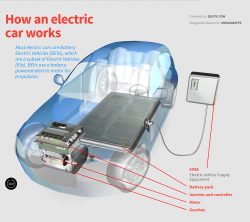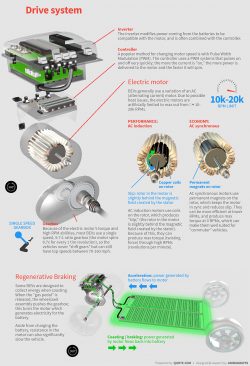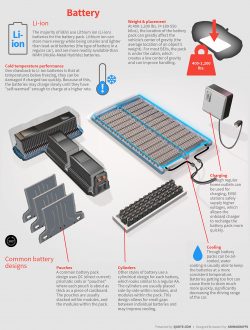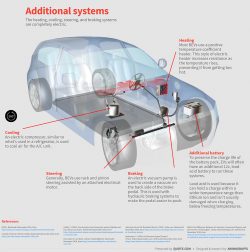How an electric car works
Most electric cars are Battery Electric Vehicles (BEVs), which are a subset of Electric Vehicles (EVs). BEVs use a battery-powered electric motor for propulsion.
PDM
Inverter and controller
Motor
Gearbox
Battery pack
EVSE
Electric Vehicle Supply Equipment
Drive system
-
PDM
The Power Delivery Module is an onboard charger for the battery pack, and converts AC (alternating current) power from the EVSE to DC (direct current) to charge the battery pack.
-
Inverter & Controller
The inverter modifies power coming from the batteries to be compatible with the motor.
The controller uses a PWM (Pulse Width Modulation) systems that pulses on and off very quickly; the more the current is "on," the more power is delivered to the motor and the faster it will spin.
-

Electric motor
BEVs generally use a variation of an AC motor. Due to possible heat issues, the electric motors are artificially limited to max out from ≈ 10-20k RPMs (revolutions per minute).
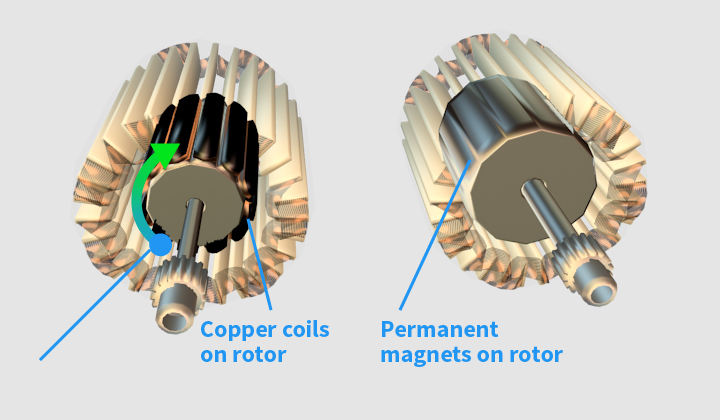
PERFORMANCE:
AC induction
Slip: rotor in the motor is slightly behind the magnetic field created by the stator
AC induction motors use coils on the rotor, which produces "slip," (the rotor in the motor is slightly behind the magnetic field created by the stator). Because of this, they can produce max torque (twisting force) through high RPMs (revolutions per minute).
ECONOMY:
AC synchronous
AC synchronous motors use permanent magnets on the rotor, which keeps the motor in sync and reduces slip. They can be more efficient at lower RPMs, and produce max torque at 0 RPMs, which can make them well suited for "commuter" vehicles.

Gearbox
Because of the electric motor’s torque and high RPM abilities, most BEVs use a single speed, 9.7:1 ratio gearbox (the motor spins 9.7x for every 1 tire revolution), so the vehicles never "shift gears" but can still have top speeds between 70-160 mph.
Regenerative Braking
Some BEVs are designed to collect energy when coasting. When the "gas pedal" is released, the wheel/axel assembly pushes the gearbox; this turns the motor which generates electricity for the battery.
Aside from charging the battery, resistance in the motor can also significantly slow the vehicle.

Acceleration: power generated by battery flows to motor

Coasting / braking: power generated by motor flows back into battery
Battery
-

Li-ion
The majority of BEVs use Lithium ion (Li-ion) batteries for the battery pack. Lithium ion can store more energy while being smaller and lighter than lead-acid batteries (the type of battery in a regular car), and are more readily available than NiMH (Nickle-Metal Hydride) batteries.
-

Cold temperature performance
One drawback to Li-ion batteries is that at temperatures below freezing, they can be damaged if charged too quickly. Because of this, the batteries may charge slowly until they have "self-warmed" enough to charge at a higher rate.
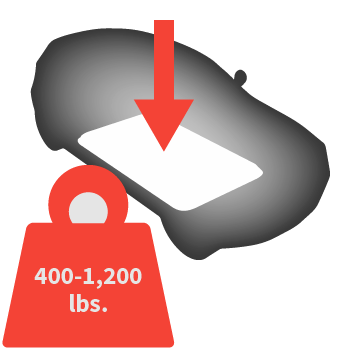
Weight & placement
At 400-1,200 lbs. (≈ 180-550 kilos), the location of the battery pack can greatly affect the vehicle’s center of gravity (the average location of an object’s weight). For most BEVs, the pack is under the cabin, which creates a low center of gravity and can improve handling.
Common battery designs
Pouches
A common battery pack design uses DC prismatic cells or "pouches" where each pouch is about as thick as a piece of cardboard. The pouches are usually stacked within modules, and the modules within the pack.
Cylinders
Other styles of battery use a cylindrical design for each battery, which looks similar to a regular AA. The cylinders are usually placed side-by-side within modules, and modules within the pack. This design allows for small gaps between individual batteries and may improve cooling.
Cooling
Though battery packs can be air-cooled, water cooling is usually able to keep the batteries at a more consistent temperature. Batteries getting too hot can cause them to drain much more quickly, significantly decreasing the driving range of the car.
Charging
Though regular home outlets can be used for charging, EVSE stations safely supply higher voltages, which allows the onboard charger to recharge the battery pack more quickly.
Additional systems
The heating, cooling, steering, and braking systems are completely electric.
Heating
Most BEVs use a positive temperature coefficient heater. This style of electric heater increases resistance as the temperature rises, preventing it from getting too hot.
Cooling
An electric compressor, similar to what’s used in a refrigerator, is used to cool air for the A/C unit.
Steering
Generally, BEVs use rack and pinion steering assisted by an attached electrical motor.
Braking
An electric vacuum pump is used to create a vacuum on the back side of the brake pedal. This is used with hydraulic braking systems to make the pedal easier to push.
Additional battery
To preserve the charge life of the battery pack, EVs will often have an additional 12v, lead-acid battery to run these systems.
Lead acid is used because it can hold a charge within a wider temperature range than lithium ion and isn’t usually damaged when charging below freezing temperatures.
References
- (2016). Retrieved 8 November 2016, from http://www.processtechnology.com/pdf/SmartOnearticle.pdf
- Control of Electric Vehicle. (2016). Retrieved 8 November 2016, from http://cdn.intechopen.com/pdfs/12061.pdf
- Gable, C. (2016). How Inverters and Converters work in Hybrids and EVs. About.com Autos. Retrieved 8 November 2016, from http://alternativefuels.about.com/od/researchdevelopment/a/inverterconverters.htm
- How Electric Cars Work. (2016). HowStuffWorks. Retrieved 8 November 2016, from http://auto.howstuffworks.com/electric-car1.htm
- Induction Versus DC Brushless Motors. (2016). Tesla.com. Retrieved 8 November 2016, from https://www.tesla.com/blog/induction-versus-dc-brushless-motors
- Vorkoetter, S. (2016). An Electronic Speed Control Primer. http://www.stefanv.com. Retrieved 8 November 2016, from http://www.stefanv.com/electronics/escprimer.html
- What's the Difference Between AC Induction, Permanent Magnet, and Servomotor Technologies?. (2016). Machinedesign.com. Retrieved 8 November 2016, from http://machinedesign.com/motorsdrives/whats-difference-between-ac-induction-permanent-magnet-and-servomotor-technologies
Share / embed code
• Copy/paste the code below to share this project on your site (in an iframe).
• We only require a link back to this page and name attribution (ex: "by Quote.com")
Sharing images
(click for large versions)
